Living Fences: Planning, Planting, And Maintenance

Table of Contents
Planning Your Living Fence
Before you even touch a shovel, careful planning is crucial for a successful living fence. This section covers selecting the right plants, designing your fence layout, and preparing the planting site.
Choosing the Right Plants
Selecting the appropriate plants is the cornerstone of a thriving living fence. Consider these factors:
- Climate and Hardiness Zones: Research plants suitable for your specific hardiness zone to ensure they can withstand your local climate's coldest temperatures. This is vital for the survival and long-term health of your hedge.
- Soil Type: Different plants thrive in different soil conditions. Determine whether your soil is sandy, clay, loamy, or a combination, and choose plants that flourish in that type of soil. A soil test can provide valuable insights.
- Desired Height and Width: Envision the mature size of your living fence. Will it be a tall privacy screen, a low-growing border, or something in between? Choose plants accordingly, considering their mature height and spread.
- Evergreen vs. Deciduous: Evergreen hedges offer year-round screening and visual interest, while deciduous hedges provide seasonal color changes and can allow more sunlight through in winter.
- Flowering vs. Non-Flowering: Incorporate flowering hedges for added beauty and attract pollinators. Consider the flowering period and the overall aesthetic you desire.
- Thorny Hedges for Security: For enhanced security, consider thorny plants like Hawthorn or Pyracantha.
- Popular Hedge Plant Examples: Here are some popular choices for living fences:
- Privet: Fast-growing and adaptable, ideal for quick privacy screens.
- Holly: Evergreen with beautiful berries, offering year-round interest and a natural barrier.
- Hawthorn: Thorny and dense, providing excellent security and a wildlife habitat.
- Boxwood: Classic and formal, perfect for structured hedges.
- Leyland Cypress: Fast-growing and tall, ideal for windbreaks and privacy screens.
[Insert Images of various hedge plants here]
Designing Your Living Fence Layout
The layout of your living fence significantly impacts its overall effectiveness and aesthetic appeal.
- Purpose of the Fence: Define the primary function of your living fence. Is it for privacy, wind protection, a sound barrier, or simply aesthetic enhancement? This will guide your plant selection and design.
- Measurements and Layout: Accurately measure the area where you'll plant the fence. Sketch a layout, considering the mature size of the plants and the desired density of the hedge.
- Spacing Between Plants: Proper spacing is vital for optimal growth. Follow the recommended spacing guidelines for your chosen plant species. Overcrowding can lead to competition for resources and stunted growth.
- Future Growth: Account for the plants' mature size and how they'll grow over time. Plan for potential trimming and shaping needs.
[Insert Diagrams or Illustrations of different fence layouts here]
Preparing the Site
Thorough site preparation ensures healthy plant establishment and long-term success.
- Clear the Area: Remove all weeds, debris, rocks, and any other obstacles from the planting area. This prevents competition for resources and improves drainage.
- Soil Improvement: Amend the soil with compost or other organic matter to improve drainage, aeration, and nutrient content. This provides a healthy growing environment for your plants.
- Soil pH Testing: Test your soil's pH level. Many plants thrive within a specific pH range. Adjust the pH if necessary using lime or sulfur.
Planting Your Living Fence
Once your planning is complete, it's time to get your hands dirty!
Planting Techniques
Proper planting techniques ensure your hedge establishes a strong root system.
- Digging Holes or Trenches: Dig individual holes for smaller plants or a continuous trench for larger plants or a more uniform look. The hole or trench should be wide and deep enough to accommodate the root ball comfortably.
- Handling Plants: Carefully remove plants from their containers, gently loosening the root ball if necessary, being mindful not to damage the roots.
- Planting Depth: Plant at the correct depth. The root flare (where the trunk meets the roots) should be visible at soil level. Planting too deep can suffocate the plant.
- Watering: Thoroughly water the newly planted plants to settle the soil and help establish the roots.
[Include step-by-step photos or videos illustrating the planting process here]
Watering and Aftercare
Consistent care is essential for the establishment of your living fence.
- Regular Watering: Water regularly, especially during the first growing season, to keep the soil consistently moist. Reduce watering frequency as plants mature.
- Mulching: Apply a layer of mulch (wood chips, straw) around the base of the plants to retain moisture, suppress weeds, and regulate soil temperature.
- Pest and Disease Monitoring: Regularly inspect your plants for signs of pests or diseases. Address any problems promptly to prevent widespread damage.
- Fertilizing: Fertilize your hedge according to the plants' needs, using a balanced fertilizer. Follow product instructions carefully.
Maintaining Your Living Fence
Ongoing maintenance ensures your living fence remains healthy, beautiful, and provides the benefits you desire.
Pruning and Shaping
Regular pruning is key to maintaining the shape, size, and health of your living fence.
- Regular Pruning: Prune regularly to maintain the desired height and width. The frequency of pruning will vary depending on the plant type.
- Pruning Techniques: Learn the appropriate pruning techniques for your chosen plant species. This could involve hedging shears, loppers, or hand pruners.
- Pruning Timing: The best time to prune depends on the plant type. Some are best pruned in late winter or early spring, while others prefer summer pruning.
- Using Proper Tools: Use sharp, clean tools to prevent the spread of diseases and ensure clean cuts.
[Include visual guides on pruning techniques here]
Pest and Disease Control
Early detection and intervention are crucial for managing pests and diseases.
- Identifying Problems: Learn to identify common pests and diseases affecting your plant species.
- Natural Pest Control: Employ natural pest control methods whenever possible, such as organic sprays or introducing beneficial insects.
- Chemical Controls: Use chemical controls only as a last resort and always follow label instructions carefully.
- Regular Inspection: Regularly inspect your plants for signs of pests or diseases to catch problems early.
Winter Protection (if needed)
Some young plants may require winter protection, especially during harsh winters.
- Mulching: A thick layer of mulch around the base of the plants provides insulation and protects roots from freezing temperatures.
- Wrapping: Consider wrapping young plants with burlap or other protective materials to shield them from cold winds and frost.
- Specific Plant Needs: Research the specific winter care requirements for your chosen plant species.
Conclusion
Creating a beautiful and functional living fence is a rewarding project that adds significant value and charm to your property. By carefully planning, planting, and maintaining your hedge, you can enjoy years of natural beauty and the many benefits of a living fence—from increased privacy and enhanced curb appeal to a welcoming habitat for wildlife. Remember to choose plants suitable for your climate and soil, prepare the site properly, and follow a consistent maintenance schedule. Start planning your own stunning living fence today! Learn more about choosing the perfect plants for your living fence project and transform your outdoor space.

Featured Posts
-
 Venlonaar 16 Veroordeeld Voor Gewapende Overval Op Schoolgenoten
May 29, 2025
Venlonaar 16 Veroordeeld Voor Gewapende Overval Op Schoolgenoten
May 29, 2025 -
 Stranger Things Season 5 A 2011 Movie Thats Eerily Similar
May 29, 2025
Stranger Things Season 5 A 2011 Movie Thats Eerily Similar
May 29, 2025 -
 Netherlands Eurovision 2025 Getting To Know Claude
May 29, 2025
Netherlands Eurovision 2025 Getting To Know Claude
May 29, 2025 -
 Oranjegekte Naar Liverpool Titelstrijd Trekt Nederlandse Supporters
May 29, 2025
Oranjegekte Naar Liverpool Titelstrijd Trekt Nederlandse Supporters
May 29, 2025 -
 Taylor Dearden Getting To Know Her Parents
May 29, 2025
Taylor Dearden Getting To Know Her Parents
May 29, 2025
